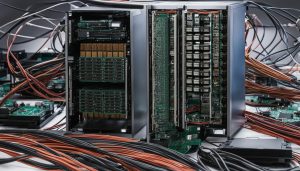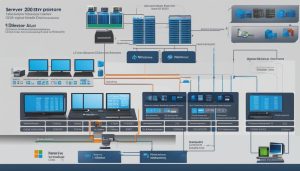Welcome to my article where we delve into the fascinating world of Windows 95. In this section, we will discuss the basics of this groundbreaking operating system, its significance in the history of Windows, and its impact on personal computing.
Windows 95, released by Microsoft in August 1995, was a game-changing operating system that revolutionized the way we interacted with computers. It introduced a graphical user interface, allowing users to navigate the system effortlessly with the click of a mouse. This innovation made PCs more user-friendly and accessible to a broader audience.
With Windows 95, multitasking capabilities were introduced, enabling users to run multiple applications simultaneously without experiencing performance issues. Additionally, the introduction of plug and play functionality simplified the installation of new hardware devices, eliminating the need for manual driver installations.
Windows 95 set the stage for future versions of Windows and became the stepping stone for modern operating systems. It revolutionized personal computing and paved the way for advancements we enjoy today.
Key Takeaways:
- Windows 95 was a game-changing operating system released by Microsoft in 1995.
- It introduced a graphical user interface, multitasking capabilities, and plug and play functionality.
- Windows 95 made PCs more user-friendly and capable of running multiple applications simultaneously.
- It set the standard for modern operating systems and laid the foundation for future versions of Windows.
- Windows 95 was a significant milestone in the evolution of personal computing.
Features of Windows 95
Windows 95 introduced several groundbreaking features that revolutionized personal computing. One of the key features was its graphical user interface (GUI), which made it easier and more intuitive for users to navigate the operating system. Instead of relying on text-based commands, users could now interact with icons, buttons, and menus.
Another significant feature of Windows 95 was its multitasking capabilities. This meant that users could run multiple applications simultaneously, allowing for increased productivity and efficiency. With Windows 95, switching between tasks became seamless, and users no longer had to close one program to open another.
Windows 95 also introduced the redesigned Start button and Taskbar, which made it easier to launch programs and switch between open windows. The Start button became a central hub for accessing applications, files, and settings, while the Taskbar provided a visual representation of all open programs, allowing for quick and easy task management.
Windows 95 Release Date
Windows 95 was released on August 24, 1995, to much anticipation and excitement. It was a significant milestone in the history of personal computing, as it marked a shift towards a more user-friendly and visually appealing operating system. The release of Windows 95 brought about a new era of computing and paved the way for future advancements in technology.
Windows 95 System Requirements
To run Windows 95, users needed a computer with a minimum of a 386DX processor, 4MB of RAM, and 50-55MB of hard drive space. These requirements ensured that Windows 95 could run smoothly and deliver a seamless user experience. While these specifications may seem modest by today’s standards, they were considered high-end at the time of Windows 95’s release.
| Processor | RAM | Hard Drive Space |
|---|---|---|
| 386DX | 4MB | 50-55MB |
Windows 95 Installation and Support
Installing Windows 95 was a relatively straightforward process that involved booting the computer from a floppy disk or CD-ROM. Users would then follow the on-screen instructions to complete the installation. However, there were a few important considerations to keep in mind.
First, it was crucial to ensure that the hardware met the system requirements specified by Windows 95. This included having a compatible processor, a sufficient amount of RAM, and enough available hard drive space. Without meeting these requirements, the installation process could encounter issues or fail altogether.
Additionally, it was important to have the necessary drivers for the computer’s devices. Windows 95 provided support for a wide range of hardware, but it was essential to have the correct drivers to ensure compatibility and optimal performance. These drivers could usually be obtained from the manufacturer’s website or included with the hardware itself.
After successfully installing Windows 95, users could enjoy the many benefits and features of the operating system. However, it’s important to note that Microsoft ended support for Windows 95 on December 31, 2001. Despite this, some users continued to use the operating system, and a few third-party companies provided limited support for those who chose to stick with Windows 95.
Windows 95 Installation Process:
| Step | Instructions |
|---|---|
| Step 1 | Boot the computer from the Windows 95 installation media (floppy disk or CD-ROM). |
| Step 2 | Follow the on-screen instructions to begin the installation process. |
| Step 3 | Ensure that your hardware meets the system requirements specified by Windows 95. |
| Step 4 | Have the necessary drivers ready for your computer’s devices. |
| Step 5 | Complete the installation process and enjoy the features of Windows 95. |
While Windows 95 may be a thing of the past, its impact on the world of personal computing cannot be overstated. It paved the way for more user-friendly and capable operating systems, setting the stage for the future of technology. Whether you were there to experience it firsthand or just curious about its history, Windows 95 will always be remembered as a groundbreaking milestone in the evolution of computing.
Windows 95 and Plug and Play
Windows 95 introduced the revolutionary concept of Plug and Play, which transformed the way devices were installed and configured on a computer. With Plug and Play, users no longer had to manually install drivers or configure settings for new devices. Instead, the operating system took care of everything automatically.
The Plug and Play functionality of Windows 95 was made possible by its innovative Plug and Play architecture. This architecture allowed devices to self-identify and specify their capabilities and resource requirements. When a new device was connected to the computer, Windows 95 would detect it, retrieve the necessary drivers, and configure it for use.
Plug and Play made it incredibly easy for users to add and remove hardware without the need for manual intervention. It simplified the process of upgrading or expanding a computer system, allowing users to seamlessly integrate new devices into their setup. Whether it was connecting a printer, a scanner, or a joystick, Windows 95 made the entire process as simple as plugging in and playing.
Windows 95’s Plug and Play functionality was a significant advancement in the world of personal computing. It eliminated the need for users to have in-depth technical knowledge or spend hours configuring new devices. Plug and Play was a game-changer, making it more accessible for everyone to take advantage of the latest hardware.
Ultimately, Windows 95’s Plug and Play capabilities set a new standard for device installation and configuration. It paved the way for future advancements in the world of computing, ensuring that adding new hardware to a computer would never be the same again.
Evolution of Windows: Windows 95 and Beyond
The release of Windows 95 marked a significant turning point in the evolution of the Windows operating system. With its introduction of groundbreaking features and technologies, Windows 95 set the stage for the modern operating systems we use today.
Building upon the success of Windows 95, subsequent versions of Windows, such as Windows 98, Windows XP, Windows 7, and the current Windows 10, have continued to push the boundaries of what a computer operating system can do. Each iteration has brought new enhancements, improvements, and compatibility with emerging technologies, ensuring that Windows remains at the forefront of the industry.
From the graphical user interface to multitasking capabilities and plug and play functionality, Windows 95 laid the foundation for future advancements. Its user-friendly interface made personal computing more accessible to the masses, while the ability to run multiple applications simultaneously revolutionized productivity. Additionally, the introduction of plug and play simplified the process of adding and removing hardware, making it easier for users to upgrade and customize their systems.
As we look back at the evolution of the Windows operating system, we can’t help but recognize the significant impact that Windows 95 had on the industry. It paved the way for the modern computing experience we enjoy today, shaping the direction of technology and setting the standard for operating systems to come.
With each new version of Windows, Microsoft continues to innovate and redefine what is possible in the world of computing. From improved security features to seamless integration with cloud services and advanced user interfaces, the evolution of Windows shows no signs of slowing down. The legacy of Windows 95 lives on in the DNA of each subsequent release, reminding us of the innovation and progress that continues to drive the Windows operating system forward.
Conclusion
In conclusion, Windows 95 was a groundbreaking operating system that revolutionized personal computing. Its introduction of a graphical user interface, multitasking capabilities, and plug and play functionality set the stage for modern operating systems.
Windows 95 was widely adopted by users and served as the foundation for subsequent versions of Windows. Although support for Windows 95 has ended, it remains an influential milestone in the history of technology.
If you are interested in experiencing the nostalgia of Windows 95, you can find various resources online to download and install the operating system. However, please note that using Windows 95 may limit your access to modern hardware and software compatibility.
Should you decide to pursue a Windows 95 installation, keep in mind that support for the operating system is no longer available. However, you may still find limited assistance from third-party companies or online communities dedicated to preserving the legacy of Windows 95.
FAQ
What is Windows 95?
Windows 95 was a game-changing operating system released by Microsoft in August 1995. It introduced several groundbreaking features such as a graphical user interface, multitasking capabilities, and plug and play functionality.
When was Windows 95 released and what were its system requirements?
Windows 95 was released on August 24, 1995. Its system requirements included a 386DX processor, 4MB of RAM, and 50-55MB of hard drive space.
How do I install Windows 95?
To install Windows 95, you need to boot the computer from a floppy disk or CD-ROM and follow the on-screen instructions. Make sure your hardware meets the system requirements and that you have the necessary drivers for your devices.
How long was Windows 95 supported by Microsoft?
Microsoft supported Windows 95 until December 31, 2001, after which support was discontinued. However, some third-party companies provided limited support for the operating system.
What is Plug and Play in Windows 95?
Plug and Play functionality in Windows 95 allows for automatic device detection and configuration. Simply plug in a Plug and Play device, and the operating system will detect and configure it without the need for manual driver installation.
How did Windows 95 influence the evolution of Windows?
Windows 95 laid the foundation for future versions of Windows, introducing features and technologies that would become standard in later releases. It paved the way for modern operating systems like Windows 10.
Janina is a senior specialist in information technology


